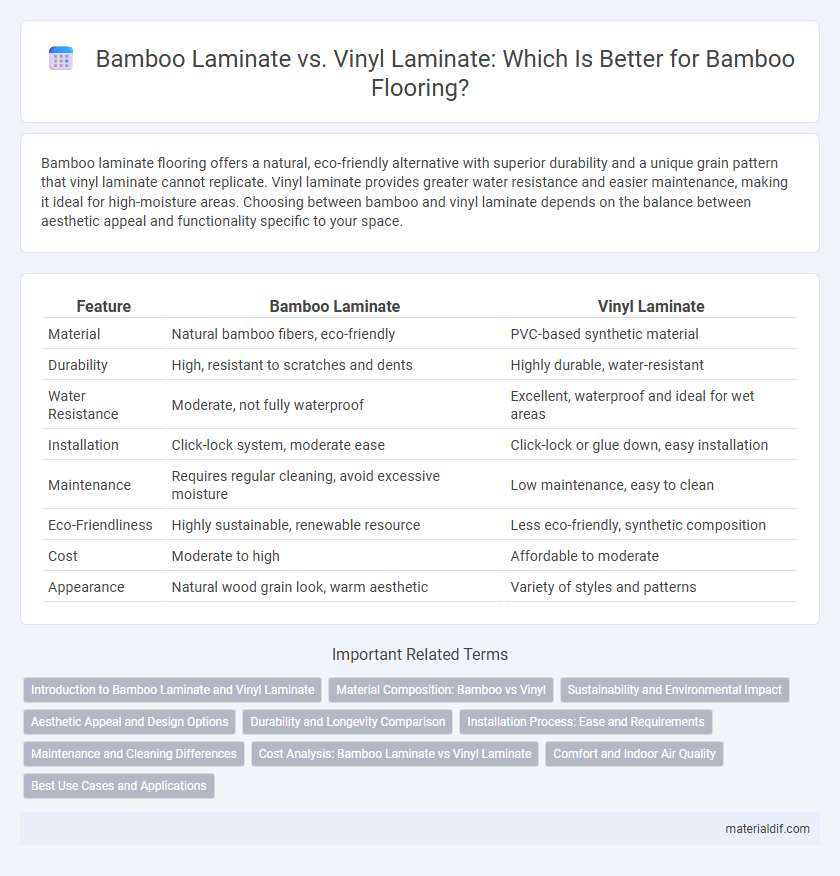Bamboo laminate flooring offers a natural, eco-friendly alternative with superior durability and a unique grain pattern that vinyl laminate cannot replicate. Vinyl laminate provides greater water resistance and easier maintenance, making it ideal for high-moisture areas. Choosing between bamboo and vinyl laminate depends on the balance between aesthetic appeal and functionality specific to your space.
Table of Comparison
| Feature | Bamboo Laminate | Vinyl Laminate |
|---|---|---|
| Material | Natural bamboo fibers, eco-friendly | PVC-based synthetic material |
| Durability | High, resistant to scratches and dents | Highly durable, water-resistant |
| Water Resistance | Moderate, not fully waterproof | Excellent, waterproof and ideal for wet areas |
| Installation | Click-lock system, moderate ease | Click-lock or glue down, easy installation |
| Maintenance | Requires regular cleaning, avoid excessive moisture | Low maintenance, easy to clean |
| Eco-Friendliness | Highly sustainable, renewable resource | Less eco-friendly, synthetic composition |
| Cost | Moderate to high | Affordable to moderate |
| Appearance | Natural wood grain look, warm aesthetic | Variety of styles and patterns |
Introduction to Bamboo Laminate and Vinyl Laminate
Bamboo laminate is a sustainable flooring option made by compressing bamboo fibers into durable planks, offering a natural aesthetic and excellent hardness. Vinyl laminate consists of synthetic materials layered to mimic the appearance of wood or stone while providing water resistance and ease of maintenance. Both materials present versatile flooring solutions with distinct environmental impacts and performance characteristics.
Material Composition: Bamboo vs Vinyl
Bamboo laminate is composed of natural bamboo fibers that are fused under high pressure with eco-friendly resins, offering a strong, renewable, and biodegradable material. Vinyl laminate consists primarily of polyvinyl chloride (PVC) combined with plasticizers and stabilizers, making it highly moisture-resistant but derived from non-renewable petrochemicals. The natural composition of bamboo laminate provides superior sustainability and breathability, whereas vinyl laminate emphasizes durability and water resistance through synthetic materials.
Sustainability and Environmental Impact
Bamboo laminate offers superior sustainability compared to traditional vinyl laminate due to its renewable source and faster growth rate, allowing for rapid replenishment without deforestation. Unlike vinyl laminate, which is derived from non-renewable petroleum and releases harmful chemicals during production and disposal, bamboo laminate is biodegradable and generates a significantly lower carbon footprint. Choosing bamboo laminate supports eco-friendly manufacturing practices and reduces long-term environmental impact by minimizing plastic waste and chemical pollutants.
Aesthetic Appeal and Design Options
Bamboo laminate offers a natural, warm aesthetic with unique grain patterns that enhance interior spaces, while vinyl laminate provides a versatile range of colors and textures, including wood and stone looks, suited for diverse design preferences. Bamboo's eco-friendly appeal complements sustainable design themes, whereas vinyl laminate excels in replicating high-end finishes at a lower cost. Both materials offer customizable options, but bamboo laminate stands out for its organic beauty and environmental benefits.
Durability and Longevity Comparison
Bamboo laminate flooring offers superior durability due to its natural hardness and resistance to dents and scratches, making it ideal for high-traffic areas. Vinyl laminate, while more flexible and water-resistant, tends to have a shorter lifespan, averaging 10-20 years compared to bamboo's potential 20-30 years with proper maintenance. The dense fiber structure of bamboo enhances its longevity, whereas vinyl's synthetic composition may degrade faster under heavy use or exposure to harsh elements.
Installation Process: Ease and Requirements
Bamboo laminate flooring typically requires a floating installation method, which involves interlocking planks without adhesive, making it easier and faster for DIY projects. Vinyl laminate often utilizes a click-lock system as well, but its flexibility allows for installation over various subfloors, including concrete, without extensive preparation. Both materials demand precise subfloor leveling, though vinyl laminate tends to be more forgiving of minor imperfections, reducing installation complexity.
Maintenance and Cleaning Differences
Bamboo laminate requires gentle cleaning methods such as damp mopping with mild soap to maintain its natural finish and prevent moisture damage, while vinyl laminate tolerates more aggressive cleaning agents and moisture, making it easier to handle stains and spills. Bamboo's susceptibility to scratches and water infiltration demands immediate wiping of spills, whereas vinyl laminate's waterproof surface allows for more forgiving maintenance routines. Regular use of non-abrasive cleaners preserves bamboo laminate's durability, contrasting with vinyl's resistance to wear and chemical exposure.
Cost Analysis: Bamboo Laminate vs Vinyl Laminate
Bamboo laminate flooring generally costs between $5 and $8 per square foot, offering an eco-friendly option with a natural aesthetic, while vinyl laminate ranges from $2 to $5 per square foot, providing a more budget-friendly, water-resistant choice suitable for high-moisture areas. Installation costs for bamboo laminate are typically higher due to the need for specialized cutting tools and experienced labor, whereas vinyl laminate installations are often quicker and less expensive. Long-term maintenance expenses favor bamboo laminate with its durability and potential for refinishing, whereas vinyl laminate may require more frequent replacement in high-traffic or heavily used spaces.
Comfort and Indoor Air Quality
Bamboo laminate offers superior comfort due to its natural fibers, which provide better thermal regulation and a softer underfoot feel compared to vinyl laminate. It also enhances indoor air quality by emitting fewer volatile organic compounds (VOCs), making it a healthier choice for living spaces. Vinyl laminate, while durable and water-resistant, often contains synthetic chemicals that can negatively impact air quality and comfort over time.
Best Use Cases and Applications
Bamboo laminate offers superior eco-friendliness and hardness, making it ideal for residential flooring, high-traffic areas, and sustainable interior designs. Vinyl laminate excels in moisture resistance and durability, suitable for bathrooms, kitchens, and commercial spaces requiring easy maintenance. Both materials provide versatile aesthetics but are chosen based on specific environmental conditions and usage demands.
Bamboo laminate vs Vinyl laminate Infographic

 materialdif.com
materialdif.com